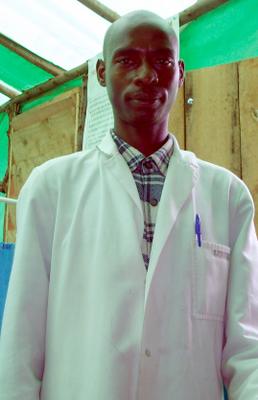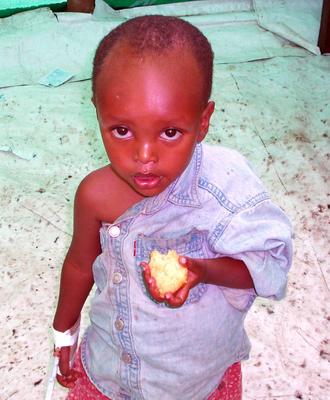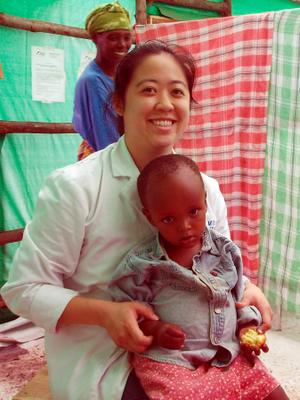What happened to October? (and sorry Sox fans.. *Red* Sox fans that is.)
Post finally finished!
I know it's been such a long time - the past two weeks have been exhausting - malaria and more malaria...
I just wanted to post these pictures... Christmas came early this year for the children in Nyabiheke refugee camp in the form of such a generous flood of supplies from the staff at MGH Chelsea Urgent care... I received 4 huge boxes full of crayons and coloring books, medical supplies, *candy* and soap for the refugees. Thank you thank you thank you. You will all be happy to know that the post office gave me *NO* trouble. It was the same lady that I broke down in front of 2 months ago and she looked so afraid that I'd start crying again that she didn't even open the packages... :) The first two pictures are here at Top's place (the Senegalese finance administrator for ARC Rwanda, Theodore (camp manager) and I stay with him when we go to the BIG city !) We are in Kigali opening the packages - we got out of a meeting late Friday night so waited until the morning to open them... it was really like Christmas morning - all of us in our pajamas still opening the boxes. I am overwhelmed by all of your generosity ... will be posting pictures to show the supplies in good use. Thanks Mom & dad and Tim,Leigh Anne and Emily for your packages of goodies too - I got 6 packages on the same day and after such bone-numbing weariness it definitely injected some energy in me :)


**********************************************************************************
Signs of Life
Damiscen came nearly every day to the health center starting in July then most of August. He wanted to volunteer – to be trained in basic nursing skills. Too much on my hands already and warned by the staff to be a little wary of “volunteers” (ie at some point they may complain to UNHCR or others that they are being exploited and demand compensation). But his persistence finally won over and starting September he came with his friend Davota every day.
A veterinarian of sorts in his previous life in the
 Our "med-student volunteer" Damiscen sporting his new white coat...
Our "med-student volunteer" Damiscen sporting his new white coat... Professor Shayka teaching our full waiting room in the morning
Professor Shayka teaching our full waiting room in the morningWe have started a daily education campaign with a morning lecture to the patients “waiting room” Shayka one of the refugee nurses has earned the nickname of “professor” because of his love of giving these lectures. Each week is a different topic, dysentery, malaria, skin infections – and Monday I give a short discourse to the nurses who then take turns each morning teaching the patients… It’s hard to quantify but I think small inroads in education are being made…
********************************************************************************
A malaria mystery and miracle
“Something’s wrong with this quinine” It’s a comment I repeat over and over to Nicole our head nurse and pharmacist. Malaria has been a huge cause of morbitiy ever since I arrived in July, but these two weeks we are being inundated with treatment failures. We had switched from the government recommended Amodiaquine/Fansidar combination in September because of all the treatment failures we had been having with that combination… Patients coming back, swearing they had been taking their medicine – appropriately describing which pills they took when and how much … yet returning requiring intravenous therapy. That had diminished significantly since we switched to quinine. The quinine regimen is longer (7 days as opposed to 3) and has more side effects (tinnitus, vertigo) but we rarely had a patient return needing hospitalization if they were placed on oral quinine. The increase in cost (about $1.20 per adult patient per course as opposed to 70 cents) was well worth the price when the cost of IV therapy / inpatient hospitalization is considered with treatment failures from Amodiaquine/Fansidar.
With the start of the rainy season however – in full force in October – we were going into the 2nd week of October and patients were being carried in every 10-15 minutes having previously been seen by me or another of my staff, diagnosed clinically with malaria, started on quinine, yet coming back even sicker. It’s disheartening to say the least. There was a “war zone” mentality – with 2/3 of my staff out with malaria themselves, it was all I could do to keep up with the skeleton staff I had and despite the rain, temperatures still reaching so high inside the radiant oven of a tent we were working in. I always caused a little bit of commotion from the surrounding patients and staff when hourly I would need to go to the water pump in back of the health tent to splash water over my entire head just to keep cool. We converted our pedi consultation ward into an ER, taught the guards how to take temperatures and stacked up patients wherever we could find room. It was an assembly line of IV D50 boluses and quinine infusions… but no deaths … I can’t imagine how no one possibly died.. I think we just got lucky given the patient numbers and lack of staff …
There seemed to be several possibilities for this surge in treatment failures…. 1) Patient noncompliance (but the pill count, and description of how they had been takiing their meds was correct) 2) Mistaken diagnosis (entirely possible without a laboratory but patients got dramatically better after their first infusion of intravenous quinine) 3) Quinine resistance (very rare but possible, but once again patients got better with IV quinine and oral has fairly good absorption ) or 4) Defective quinine tablets. Another of the articles I downloaded from the NEJM (what did we *ever* do without the internet) quoted a rate of almost 40% “fake” mediations in this part of the world and it’s true we had switched our supplier… from Congolese to Ugandan quinine tables. Supporting this hypothesis was the fact that it was largely adults that were coming in so sick. The quinine syrup and drops we gave to the children and infants were from the same supplier as we previously contracted with and seemed to be effective… So we switched back to Amodiaquine/Fansidar –which was not extremely effective but less *ineffective* than the defective quinine… and waited for
 Micyo the day before discharge
Micyo the day before dischargeMy “favorite” malaria case of those crazy two weeks was this child you see pictured here. Each night I had been pouring over the articles on malaria I had stored on my laptop – trying to figure out the best way to treat the patients with the resources we had – (and it didn’t help in the midst of all this that I received a reply from the Red Cross of Rwanda that they would *not* be able to supply any bed nets for the camp… initially they had been so encouraging)… but I fell asleep on Wednesday night.. under *my* mosquito net reading about the manifestation in young children of focal seizure activity secondary to hypoglycemia as a presentation of malaria… I awoke at 4 AM with the sound of a vehicle pulling up to the house. It had to be an emergency … it’s the only reason a driver comes at that hour to our house.. so I wearily dragged myself out of bed and opened the door. My drivers are always surprised at how light a sleeper I am .. it comes from all those years of taking call …this ability to switch on and off so quickly… When I arrive at camp, Louise and Betty 2 of the nurses are around the bed of a 2 yo child who is unresponsive. They have been trying for nearly 2 hours to get an IV but have not been successful. The child has been unresponsive in total for about 4 hours. Looking at him I see immediately that he is having a focal seizure, his eyes are deviated to the right and there is faint twitching of his mouth… I try for an IV but by this point he is so cold (T 35 celcius) and has been stuck so many times… that it’s not an easy task. We give an IM injection of diazepam, then drop by drop under his tongue of 50% Glucose and within 15 minutes he stops seizing and starts calling for his mother. Call it karma or coincidence but I’d like to think it was pure grace… it’s nothing short of a miracle – that I had fallen asleep with that specific article just 5 hours before being collected for this emergencey and there wasn’t even a question in my mind what the diagnosis or proper treatment should be… It’s one of the most gratifying moments here to date when his mother takes my hand and says (as translated by Betty “If we were still in the Congo, my child would be dead” Micyo does well over the course of the next couple days in the hospital and cries only when he is told he has to leave because he is well enough to go home… (a welcome change from most children’s attitudes toward hospitals)

**********************************************************************************
Babies taking care of babies, and no school in sight...

The children here are all so beautiful – and I don’t mean that in a maudlin dewy eyed “every child is beautiful in their own way Hallmark card” kind of sentiment. They really are amazing – literally playing with rocks – prized possessions are empty plastic bottles from which they make toy cars.. we have over 1200 children less than five years old in this camp, and eighty households headed by children under 17. They face each day hungry, alternatingly drenched to the bone and frying in the extreme heat, the only clothes the rags on their back, chronically infested with scabies and worms – yet each day they run to me and grab my hands with smiling faces practicing the few bits of English they have picked up “good morning” (no matter what time of day it is) “Doctor Anna.”
Often an 11 year old brings in a 5 year old and a 2 year old for consultation having the responsibility of care for the younger ones. One 14 year old, when escaping from the rebels in the Congo – having lost her entire family, found two toddlers on the 50 mile walk to the border who had been orphaned themselves and is now taking care of them here in the camp. Many grandmothers are taking care of babies having lost their own children to war and AIDS.
Since the start of this camp in April all of these children (almost 2800 less than 18 yo) have not been in school. The Rwandan school system runs from January to September and April was right in the middle… money also ran out because the cost of drilling for water and setting up the camp exceeded the budget so that even though a piece of land had been designated for a school… it wasn’t able to be built initially… Then the Rwandese government ministry of education declared that the children would have to go to local Rwandese schools (the nearest of which is 2 km away), and would have to start at the beginning of the new year in January. (This despite the fact that education the other camps in Rwanda is handled by JRS – Jesuit Relief Services – who from my understanding are doing a wonderful job, and the schools are all within the camps). In the mean time it will be 8 months without school for these children and they are growing up in an already displaced and difficult situation … now they are growing up wild. It makes my heart sick to think of 4 and 5 year olds walking down steep terrain, alone 2km to get to school… already vulnerable they will be easy prey for anyone with less than benevolent motives. Also the local schools have nowhere near the capacity to take this influx of children… and that’s the kicker – the government wants money from UNHCR or ARC or whoever to rebuild and add on extensions to the local schools…before allowing the refugee children to enroll I understand that the local schools are in need of funding also – but it seems almost like blackmail… and negotiations are at an impasse for the moment and the more time these children are out of school, the harder it will be.
Theodore has started a scouts troup with the young boys that has added a little structure to their days… it’s these young girls who are shouldering so much of the responsibility of child care, water fetching and cooking that are the hardest to contemplate…
 A young girl brings her younger sibling to our monthly immunization campaigns.
A young girl brings her younger sibling to our monthly immunization campaigns.

